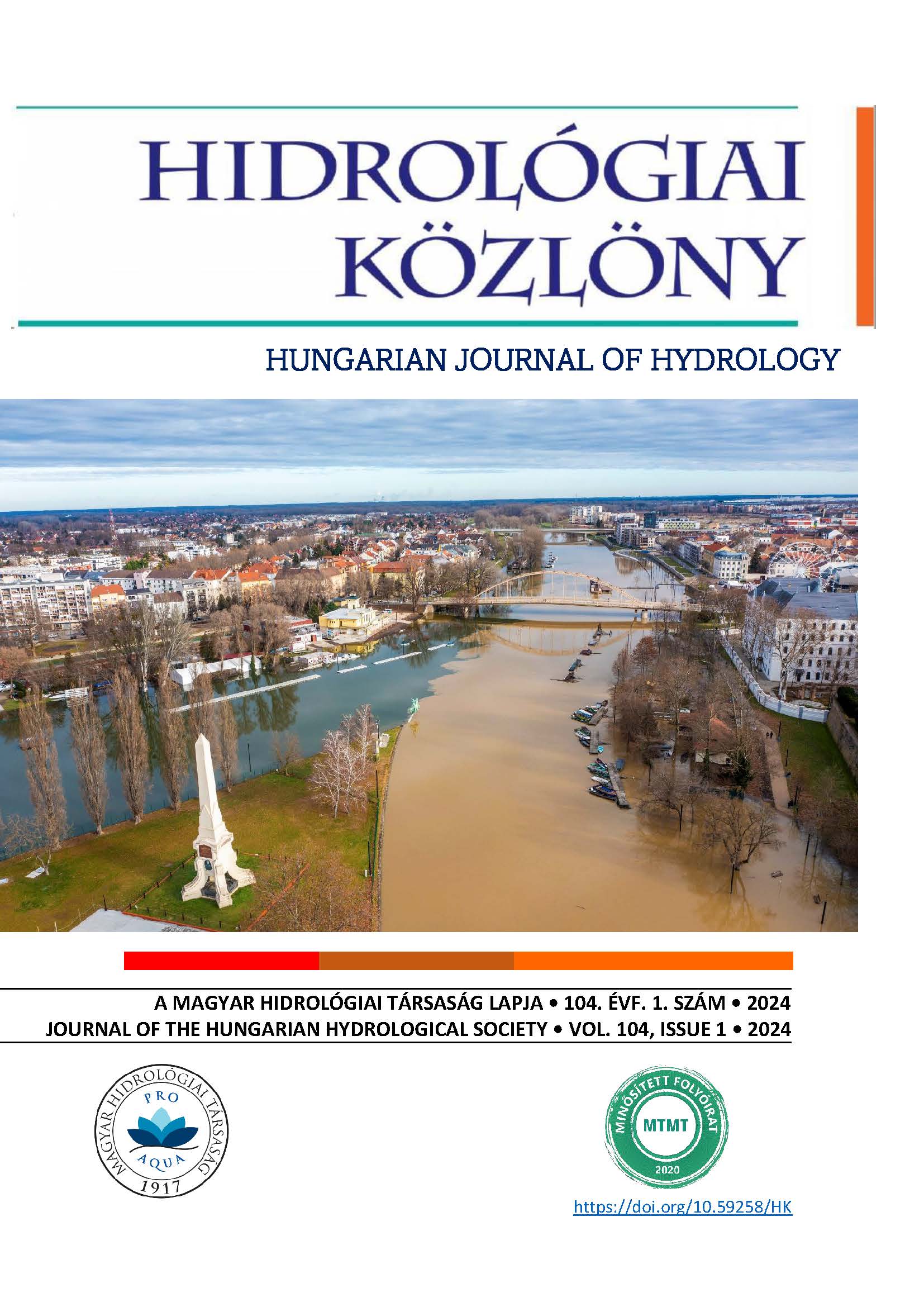Improvement of the Kovács water retention model
Abstract
In the unsaturated soil zone (vadose zone), the relationship between saturation and suction potential plays a crucial role in describing the connection, known as the water retention curve (WRC). Various models for the WRC exist, with the most widely used being the van Genuchten model. Determining the parameters of the van Genuchten model requires laboratory investigations. The advantage of the Kovács water retention model lies in its physically interpretable parameters that can be derived through independent measurements. However, a drawback is its tendency to overestimate soil saturation in lower suction ranges. This paper focuses on addressing this issue by improving the Kovács model and comparing it with the van Genuchten model using the 3D Soil Hydraulic Database of Europe v1.0. For comparison, the root mean square error (RMSE) was calculated between the results of the two methods, with parameter optimization during calibration. The improvement was achieved by a suction correction function. The average RMSE value between the van Genuchten and the original Kovács model was 0.0613, while between the van Genuchten and the modified Kovács model, the average RMSE value was 0.0145. Therefore, the modification resulted in a 4.3-fold improvement. Polynomial correlation was established between the values of the suction correction factor and the equivalent capillary rise, simplifying the computation of the modified function. With this simplification, the average RMSE value reduced to 0.0150. This represents a 3% degradation, but the improvement remains significant compared to the original Kovács function. The computations were performed for over 600 monitoring wells during optimization. Comparative analysis was conducted for 30 randomly selected monitoring wells, comparing the equivalent capillary rise derived from borehole data with the equivalent capillary rise derived from the parameters of the van Genuchten model from the 3D Soil Hydraulic Database of Europe v1.0. The correlation between the equivalent capillary rise determined by the two methods proved weak, with a correlation coefficient of R2 < 0.25. This comparison highlighted the need for further refinement of the soil hydraulic database, for which the new and improved Kovács water retention model proves suitable as a pedotransfer function.
References
Aubertin, M., Mbonimpa, M., Bussière, B., Chapuis, R.P. (2003). A model to predict the water retention curve from basic geotechnical properties. Canadian Geotechnical Journal. 40(6). pp. 1104-1122. https://doi.org/10.1139/t03-054
Darcy, H. (1856). Les Fontaines publiques de la ville de Dijon: Paris, Victor Dalmont, p. 647. plus 28 plates.
Hengl, T., Mendes de Jesus, J., Heuvelink, G.B.M., Ruiperez Gonzalez, M., Kilibarda, M., Blagotić, A. (2017). SoilGrids250m: Global gridded soil information based on machine learning. PLoS ONE 12(2): e0169748. https://doi.org/10.1371/journal.pone.0169748
Koncsos L., Schütz, E., Windau, U. (1995). Application of a comprehensive decision support system for the water quality management of the river Ruhr, Germany. In: Simonovic, S.P., Kundzewicz, Z., and Rosbjerg D. (ed.) Modelling and Management of Sustainable Basin-Scale Water Resources Systems. ISBN 0-947571-59-0. Wallingford, United Kingdom of Great Britain and Northern Ireland. IAHS Press (1995) p. 434. pp. 97-106.
Kovács Gy. (1968). Characterization of Molecular Forces Influencing Seepage by Means of the pF Curve. Agrokémia és talajtan, 17 (sup). pp. 1-12.
Kovács Gy. (1981). Seepage Hydraulics. Elsevier Scientific Publishing Company, Amsterdam; Oxford, New York. p. 730.
Mbonimpa, M., Aubertin, M., Bussière, B. (2006). Predicting the unsaturated hydraulic conductivity of granu-lar soils from basic geotechnical properties using the modified Kovács (MK) model and statistical models. Ca-nadian Geotechnical Journal. 43(8). pp. 773-787. https://doi.org/10.1139/t06-044
Monod, J. (1949). The growth of bacterial cultures. Annual Review of Microbiology. 3. pp. 371–394. https://doi.org/10.1146/annurev.mi.03.100149.002103
MTA TAKI (1991). Magyarország Agrotopográfiai Adatbázisa. Magyar Tudományos Akadémia Talajtani és Agrokémiai Kutatóintézet. Budapest.
Pásztor L., Laborczi A., Szatmári G., Takács K., Illés G., Szabó J. (2017). Mi várható a megújult hazai talaj téradat infrastruktúrától? In: Balázs B. (ed.) Az elmélet és a gyakorlat találkozása a térinformatikában VIII. ISBN 978-963-318-638-1. Debreceni Egyetemi Kiadó, Debrecen. http://giskonferencia.unideb.hu/arch/GIS_Konf_kotet_2017.pdf. pp. 277-285. Letöltve: 2023.08.17.
Richards, L.A. (1931). Capillary conduction of liquids through porous mediums. Journal of Applied Physics. 1 (5). pp. 318–333. https://doi.org/10.1063/1.1745010
Too, V., Omuto, C., Biamah, E., Obiero, J. (2014). Review of Soil Water Retention Characteristic (SWRC) Models between Saturation and Oven Dryness. Open Journal of Modern Hydrology, 4. pp. 173-182. doi: https://doi.org/10.4236/ojmh.2014.44017
Tóth B., Weynants, M., Nemes A., Makó A., Bilas G., Tóth G. (2015). New generation of hydraulic pedotrans-fer functions for Europe. Eur J Soil Sci, 66. pp. 226-238. https://doi.org/10.1111/ejss.12192
Tóth B., Weynants, M., Pásztor L., Hengl, T. (2017). 3D Soil Hydraulic Database of Europe at 250 m resolu-tion. Hydrol. Process. https://doi.org/10.1002/hyp.11203
van Genuchten, M.T. (1980). A Closed-form Equation for Predicting the Hydraulic Conductivity of Unsatu-rated Soils. Soil Science Society of America Journal, 44. pp. 892-898. https://doi.org/10.2136/sssaj1980.03615995004400050002x
Várallyay Gy., Szőcs L., Murányi A., Rajkai K., Zilahy P. (1979). Magyarország termőhelyi adottságait meg-határozó talajtani tényezők 1:100.000 méretarányú térképe I. Agrokémia és Talajtan 28. pp. 363-384. ISSN 0002-1873
Várallyay Gy., Szőcs L., Murányi A., Rajkai K., Zilahy P. (1980). Magyarország termőhelyi adottságait meg-határozó talajtani tényezők 1:100.000 méretarányú térképe II. Agrokémia és Talajtan 29. pp. 35-76. ISSN 0002-1873
Copyright (c) 2024 László Koncsos ; Gábor Murányi

This work is licensed under a Creative Commons Attribution-NonCommercial-ShareAlike 4.0 International License.




